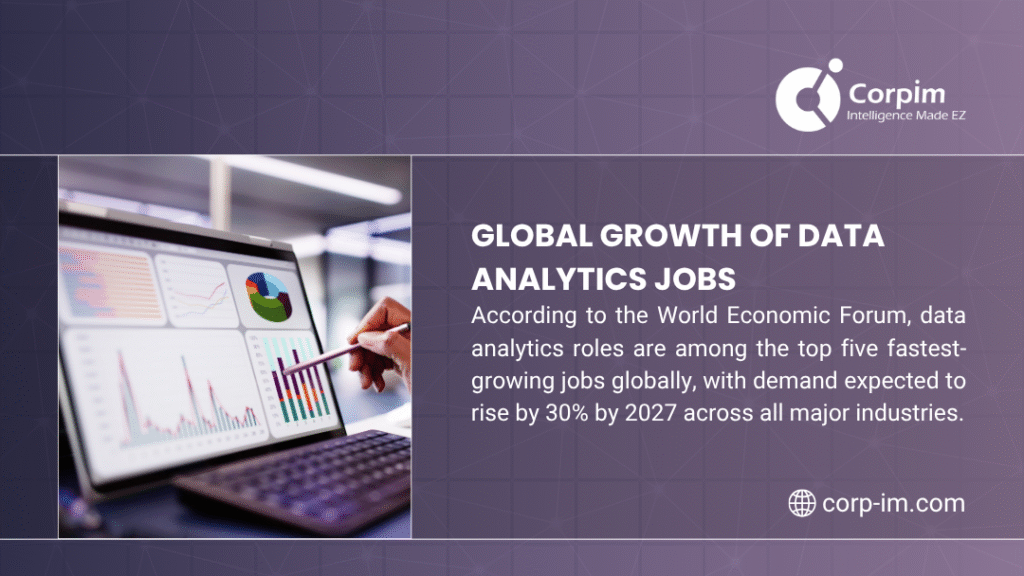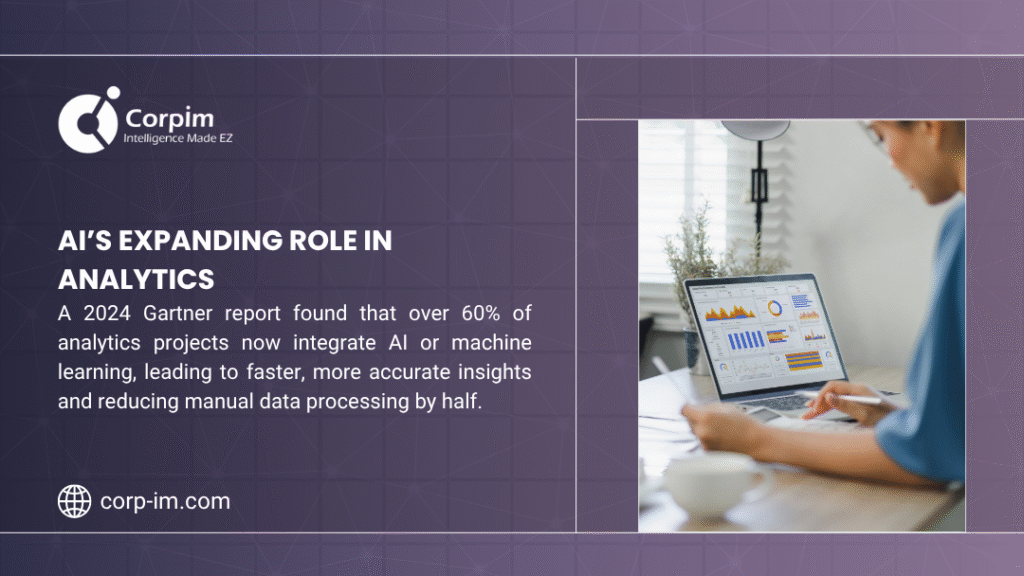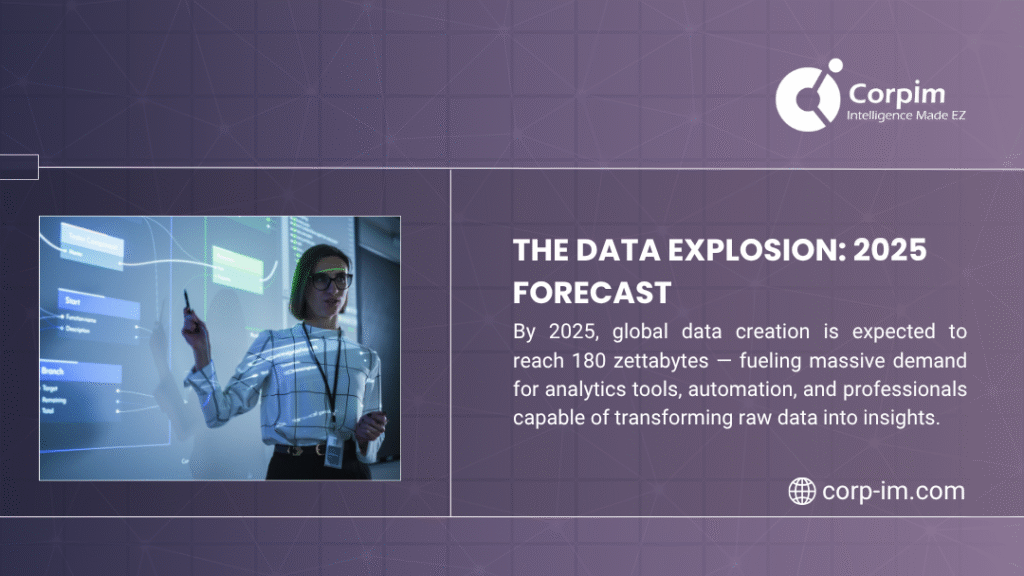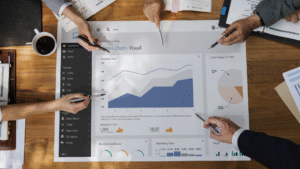Article Summary
Data analytics has become the backbone of modern business decision-making. This blog will talk about what is data analytics, why it matters, and how organizations use it to transform raw data into actionable insights. We will also talk about the different types of data analytics, the step-by-step process, essential tools, real-world applications, and how to get started with data analytics. Whether you’re a business owner, aspiring analyst, or simply curious about the field, this guide breaks down everything you need to know in simple, practical terms.
Understanding Data Analytics
Data analytics is the science of examining raw data to draw meaningful conclusions and support better decision-making. Think of it as detective work for numbers; you’re looking through information to find patterns, answer questions, and solve problems that help businesses grow.
In today’s world, every click, purchase, social media post, and transaction creates data. Companies that know how to analyze this information gain a massive advantage over those that don’t. Data analytics turns this overwhelming flood of numbers into clear, actionable insights that drive real results.
At its core, data analytics combines statistics, computer programming, and business knowledge to help organizations understand what’s happening, why it’s happening, and what might happen next. It’s not just about collecting data it’s about asking the right questions and finding answers that matter.

Why Data Analytics Matters
The importance of data analytics has grown exponentially. Modern businesses generate more data in a single day than entire companies produced in a year just a decade ago. Without proper analysis, this data is just noise. With it, you can:
- Spot opportunities before your competitors
- Understand your customers on a deeper level
- Cut costs by identifying inefficiencies
- Predict future trends and prepare accordingly
- Make decisions based on facts rather than gut feelings
According to recent industry reports, organizations that embrace data analytics are 23 times more likely to acquire customers and 6 times more likely to retain them. These aren’t small numbers, they represent the difference between thriving and merely surviving in today’s competitive landscape.
The Four Types of Data Analytics
Data analytics isn’t one-size-fits-all. Different questions require different approaches. Here are the four main types you need to understand:
- Descriptive Analytics: What Happened?
Descriptive analytics looks at historical data to understand what has already occurred. It’s the foundation of all analytics work. When you check your website traffic from last month or review quarterly sales figures, you’re using descriptive analytics.
This type answers questions like:
- How many products did we sell last quarter?
- What was our website bounce rate in January?
- Which marketing campaign generated the most leads?
Descriptive analytics uses techniques like data aggregation and data mining to summarise large datasets into understandable formats. Dashboards, reports, and visualizations are common outputs.
- Diagnostic Analytics: Why Did It Happen?
Once you know what happened, the natural next question is why. Diagnostic analytics digs deeper into the data to uncover causes and relationships. It identifies patterns and connections that explain outcomes.
This type helps you understand:
- Why did sales drop in the third quarter?
- What caused the spike in customer complaints?
- Why did one product perform better than others?
Diagnostic analytics often involves drill-down analysis, data discovery, and correlation studies. It’s about moving beyond the surface to understand the underlying factors driving your results.
- Predictive Analytics: What Will Happen?
Predictive analytics uses historical data, statistical algorithms, and machine learning techniques to forecast future outcomes. It’s not about crystal balls, it’s about identifying patterns that are likely to repeat.
This type addresses questions such as:
- Which customers are most likely to cancel their subscriptions?
- What will our sales look like next quarter?
- How much inventory should we stock for the holiday season?
Understanding how AI is transforming business intelligence has become crucial for organizations looking to implement predictive analytics effectively. Modern AI tools can process vast amounts of data to generate increasingly accurate predictions.
- Prescriptive Analytics: What Should We Do?
Prescriptive analytics is the most advanced type. It not only predicts what will happen but also suggests actions to take advantage of those predictions. It combines data, algorithms, and business rules to recommend optimal decisions.
This type answer:
- What’s the best pricing strategy to maximize revenue?
- Which marketing channels should we invest in?
- How should we allocate resources across different projects?
The difference between business intelligence vs data analytics becomes clear here, whilst business intelligence focuses on what happened and why, data analytics extends into prediction and prescription, offering a more forward-looking approach.
The Data Analytics Process: Step-by-Step Guide
Understanding the systematic approach to data analytics helps you appreciate how raw information becomes valuable insight. Here’s the complete process:
Step 1: Define Your Objectives
Before touching any data, you need clarity on what you’re trying to achieve. What questions do you need answered? What problems are you solving? Clear objectives guide every subsequent decision.
Good objectives are specific and measurable. Instead of “improve sales,” aim for “identify which product categories have the highest growth potential in the 18-35 age demographic.” The more precise your question, the more useful your analysis will be.
Step 2: Collect Relevant Data
Once you know what you’re looking for, gather the information you’ll need. Data can come from numerous sources:
- Internal databases and systems
- Customer relationship management tools
- Website and app analytics
- Social media platforms
- Third-party data providers
- Surveys and feedback forms
- Internet of Things devices and sensors
The key is collecting data that’s relevant to your objectives. More isn’t always better, you want the right data, not just lots of it.
Step 3: Clean and Prepare the Data
Raw data is messy. It contains errors, duplicates, missing values, and inconsistencies. Data cleaning, often called data wrangling, is where you prepare your information for analysis.
This step involves:
- Removing duplicate records
- Fixing errors and typos
- Handling missing values
- Standardising formats and units
- Filtering out irrelevant information
- Combining data from multiple sources
Industry experts estimate that data scientists spend 60-80% of their time on this step. It’s not glamorous, but it’s absolutely critical. Poor quality data leads to poor quality insights, regardless of how sophisticated your analysis techniques are.
For organisations dealing with large volumes of information, implementing proper data pipeline architecture best practices ensures efficient and reliable data preparation processes.
Step 4: Analyse the Data
Now comes the actual analysis. This is where you apply statistical methods, algorithms, and analytical techniques to find patterns, trends, and insights in your clean data.
The specific techniques you use depend on your objectives and data type. Common methods include:
- Statistical analysis (averages, correlations, distributions)
- Trend analysis
- Cluster analysis
- Regression analysis
- Time series analysis
- Machine learning algorithms
Modern platforms like Databricks have revolutionised this step by providing unified analytics platforms that can handle massive datasets and complex analyses efficiently.
Step 5: Visualise and Interpret Results
Numbers in spreadsheets rarely tell compelling stories. Visualisation transforms your findings into charts, graphs, and dashboards that humans can quickly understand and act upon.
Effective data visualisation:
- Highlights key findings immediately
- Makes complex information accessible
- Reveals patterns that might be missed in raw numbers
- Facilitates communication with non-technical stakeholders
What is business intelligence reporting demonstrates how organisations present analytical findings to drive decision-making across different levels of the business.
Step 6: Communicate Insights and Take Action
The final step is sharing your findings with decision-makers and stakeholders. This requires translating technical results into business language that drives action.
Strong communication includes:
- Clear presentation of key findings
- Context that explains why results matter
- Specific recommendations for action
- Acknowledgment of limitations and uncertainties
Remember, analysis without action is just an academic exercise. The true value of data analytics emerges when insights inform real decisions that improve outcomes.
Essential Data Analytics Tools for 2025
The right tools can dramatically accelerate your analytics capabilities. Here’s what modern analysts use:
| Tool Category | Examples | Best For |
| Spreadsheets | Microsoft Excel, Google Sheets | Basic analysis, small datasets, quick calculations |
| Statistical Software | R, Python (with pandas, NumPy) | Advanced statistical analysis, machine learning |
| Business Intelligence Platforms | Tableau, Power BI, Looker | Data visualisation, dashboards, reporting |
| Database Management | SQL, MySQL, PostgreSQL | Querying and managing large datasets |
| Big Data Platforms | Databricks, Apache Spark, Hadoop | Processing massive datasets, complex analytics |
| Cloud Analytics | Google Analytics, AWS, Azure | Web analytics, cloud-based processing |
The choice depends on your specific needs, data volume, technical expertise, and budget. Many organizations use a combination of tools to cover different aspects of their analytics work.
Real-World Applications Across Industries
Data analytics isn’t confined to tech companies. Every industry benefits from data-driven insights. Here’s how different sectors apply analytics:
Healthcare and Medical Services
Healthcare organisations use data analytics to improve patient outcomes, reduce costs, and streamline operations. Hospitals analyse patient data to predict which individuals are at high risk for certain conditions, allowing for preventive intervention.
Business intelligence consulting for healthcare helps medical institutions implement systems that track treatment effectiveness, identify best practices, and optimise resource allocation across departments.
Financial Services and Banking
Banks and financial institutions rely heavily on data analytics for fraud detection, risk assessment, and customer service. Credit scoring models use analytics to evaluate loan applications. Trading firms analyse market data to identify investment opportunities.
For organisations in this sector, business intelligence consulting for financial services provides specialised expertise in regulatory compliance, risk management, and customer analytics.
Manufacturing and Production
Manufacturers use analytics to optimise production processes, predict equipment failures, and manage supply chains. Predictive maintenance programs analyze sensor data from machinery to schedule repairs before breakdowns occur, saving millions in downtime costs.
Business intelligence consulting for manufacturing helps production companies implement analytics systems that improve quality control, reduce waste, and increase operational efficiency.
Retail and E-commerce
Retailers analyse purchase patterns, customer behaviour, and inventory data to optimise everything from product placement to pricing strategies. Recommendation engines that suggest products you might like are powered by sophisticated analytics algorithms.
Small retailers particularly benefit from accessible analytics tools. Understanding the benefits of business intelligence for small businesses shows how even companies with limited resources can compete effectively using data insights.
Insurance Industry
Insurance companies use data analytics for risk assessment, claims processing, and fraud detection. They analyse historical claims data, demographic information, and external factors to set premiums and identify suspicious patterns.
Business intelligence consulting for insurance companies helps insurers implement advanced analytics that improve underwriting accuracy and customer experience, whilst reducing fraudulent claims.
Data Analytics Skills You Need
Whether you’re looking to hire analysts or develop your own skills, here are the key competencies that matter:
Technical Skills
- Statistical Knowledge: Understanding probability, distributions, hypothesis testing, and correlation
- Programming: Python and R are industry standards for data analysis
- SQL Proficiency: Querying databases is fundamental to accessing data
- Data Visualization: Creating clear, compelling charts and dashboards
- Machine Learning Basics: Understanding common algorithms and when to apply them
Business Skills
- Domain Expertise: Understanding the industry and business context
- Critical Thinking: Asking the right questions and challenging assumptions
- Communication: Explaining technical concepts to non-technical audiences
- Problem-Solving: Breaking complex challenges into manageable analyses
Tools and Platforms
Familiarity with modern analytics platforms gives you practical capabilities. Cloud platforms have become particularly important, with organizations increasingly moving analytics workloads to scalable cloud environments. Understanding options like private cloud computing, public cloud computing, and hybrid cloud computing helps you choose the right infrastructure for your analytics needs.

Common Challenges in Data Analytics
Understanding potential obstacles helps you prepare for and overcome them:
Data Quality Issues
Poor quality data produces unreliable insights. Common problems include incomplete records, outdated information, inconsistent formats, and data entry errors. Addressing these requires robust data governance policies and ongoing quality monitoring.
Lack of Clear Objectives
Starting analysis without clear goals leads to wasted effort and confusion. Always begin with specific questions you need answered rather than just “looking at the data to see what’s there.”
Skills Gap
Many organisations struggle to find qualified analysts or train existing staff. This challenge is particularly acute for smaller companies competing with tech giants for talent.
Business intelligence consulting for enterprise provides one solution, bringing expert knowledge and proven methodologies to organisations that lack internal capabilities.
Technology Complexity
The analytics landscape includes hundreds of tools and platforms, each with different strengths. Choosing the right technology stack and integrating various systems can be overwhelming.
Resistance to Change
Even the best insights fail if stakeholders ignore them. Cultural resistance to data-driven decision-making remains a significant barrier in many organisations. Success requires not just technical implementation but also change management and stakeholder buy-in.
Getting Started with Data Analytics
Ready to begin your analytics journey? Here’s a practical roadmap:
For Individuals
Learn the Fundamentals: Start with basic statistics and data concepts. Free online courses from platforms like Coursera, edX, and Khan Academy provide excellent foundations.
Choose Your Tools: Begin with familiar tools like Excel before progressing to more advanced platforms. Many powerful analytics tools offer free versions for learning.
Practice with Real Data: Apply your skills to actual datasets. Websites like Kaggle offer thousands of datasets and competitions to practise on.
Build a Portfolio: Document your projects and analyses. This demonstrates your capabilities to potential employers or clients.
For Businesses
Assess Your Current State: Evaluate what data you’re already collecting and how you’re using it. Identify gaps and opportunities.
Start Small: Don’t try to transform everything at once. Begin with one specific use case where analytics can deliver clear value.
Invest in Infrastructure: Ensure you have systems to collect, store, and process data effectively. This might mean upgrading databases, implementing new tools, or moving to cloud platforms.
Develop Your Team: Hire analytics talent or train existing employees. Consider partnering with consultants for specialised expertise.
Create a Data Culture: Encourage data-driven decision-making throughout the organisation. Make data accessible and promote analytical thinking.
The Future of Data Analytics
Data analytics continues evolving rapidly. Several trends are shaping where the field is heading:
Artificial Intelligence Integration: AI and machine learning are becoming standard parts of analytics workflows, automating complex analyses that previously required manual effort.
Real-Time Analytics: Businesses increasingly need instant insights rather than historical reports. Technologies enabling real-time data processing and analysis are becoming critical.
Edge Analytics: Processing data where it’s created (on devices and sensors) rather than sending everything to centralised systems reduces latency and bandwidth requirements.
Automated Analytics: Self-service platforms that allow non-technical users to perform sophisticated analyses without coding are democratising data access.
Enhanced Privacy Measures: With the growing prevalence of data regulations worldwide, analytics systems must strike a balance between generating insights and protecting privacy while ensuring compliance.
Comparison: Data Analytics vs Related Fields
Understanding how data analytics relates to similar disciplines helps clarify its role:
| Aspect | Data Analytics | Business Intelligence | Data Science | Data Engineering |
| Primary Focus | Extracting insights from data | Reporting and monitoring | Advanced modeling and prediction | Building data infrastructure |
| Time Orientation | Past and future | Primarily past | Future-focused | Present (data flow) |
| Complexity | Moderate to high | Moderate | Very high | High (technical) |
| Main Output | Insights and recommendations | Reports and dashboards | Models and algorithms | Data pipelines and systems |
| Typical Users | Analysts, managers | Business users | Data scientists | Engineers, developers |
| Tools | Python, R, SQL, BI tools | Tableau, Power BI | Python, R, TensorFlow | SQL, ETL tools, cloud platforms |
Each discipline plays a vital role in turning data into value, and they often work together within organizations.
Conclusion
Data analytics has transformed from a specialised technical discipline into an essential business capability. Understanding what data analytics is and how it works empowers you to make better decisions, whether you’re running a business, pursuing a career, or simply want to be more data-literate in our information-rich world.
The process of defining objectives, collecting data, cleaning and preparing it, analysing patterns, visualising results, and taking action, provides a framework that applies across industries and use cases. The tools and techniques continue advancing, but the fundamental goal remains constant: turning raw information into actionable insights that drive better outcomes.
In 2025 and beyond, the organisations and individuals who excel will be those who not only collect data but truly understand how to extract meaning from it. Data analytics isn’t just about numbers and algorithms, it’s about asking better questions, finding meaningful patterns, and making decisions that are grounded in evidence rather than assumption.
Whether you’re just beginning your analytics journey or looking to deepen your existing capabilities, the key is to start. Choose a specific problem, gather relevant data, and work through the process. Each analysis teaches you something new and builds your confidence and competence.
Key Takeaways
- Data analytics transforms raw data into actionable insights that support better decision-making across all business functions and industries.
- Four types of analytics serve different purposes: descriptive (what happened), diagnostic (why it happened), predictive (what will happen), and prescriptive (what should we do).
- The analytics process follows six key steps: define objectives, collect data, clean and prepare it, analyse patterns, visualise results, and communicate insights for action.
- Every industry benefits from data analytics, from healthcare and finance to manufacturing and retail, with applications ranging from fraud detection to customer personalisation.
- Essential skills combine technical and business knowledge: statistical analysis, programming, data visualisation, and the ability to communicate findings effectively to non-technical audiences.
- Modern tools and platforms have made analytics more accessible, with options ranging from simple spreadsheets to sophisticated cloud-based systems for organisations of all sizes.
- Success requires more than just technology, it demands clear objectives, quality data, skilled people, and a culture that values data-driven decision-making over gut instinct.

Ready to Transform Your Data into Insights?
Understanding what data analytics is represents just the first step. Implementing effective analytics that drive real business results requires expertise, the right tools, and a clear strategy aligned with your objectives.
At Corpim, we specialise in helping organisations unlock the full potential of their data. Our team combines deep technical knowledge with industry-specific experience to deliver analytics solutions that work. Whether you need help building your data infrastructure, implementing advanced analytics platforms, or developing your team’s capabilities, we’re here to help.
Get in touch with us today to discuss how data analytics can transform your business. Let’s turn your data into your competitive advantage.













